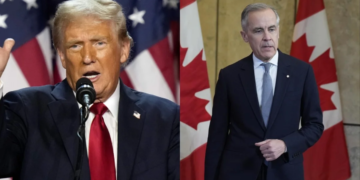Donald Trump proclaimed “Liberation Day” on April 2, 2025, to initiate a sequence of trade barriers that reorganized United States international trading schemes. The ‘reciprocal’ trade measures maintain an equal level of duty as foreign countries charge for American exports in order to establish fair international trade relations and support U.S. industrial production. The research investigates the implementation of these new liberation day tariffs and their economic logic and full technical scope together with worldwide reactions from other nations.
Details of the Liberation Day Tariffs

Press releases for “Liberation Day” tariffs show extensive custom duties for various trade items that originate from different nations. The key components include:
-
Baseline Tariff: A universal 10% tariff imposed on all imports into the United States.
-
Country-Specific Tariffs: Higher tariffs targeting specific nations, such as:
-
China: 34%
-
European Union: 20%
-
Japan: 24%
-
United Kingdom: 10%
-
Vietnam: 46%
-
-
Automobile Tariffs: A 25% tariff on all foreign-manufactured cars, aimed at encouraging domestic automobile production.
These tariffs are set to take effect immediately, with the administration emphasizing that they are a necessary step toward achieving equitable trade practices.
Economic Rationale Behind the Tariffs
President Trump introduced the “Liberation Day” tariffs to rectify trade policies which according to his belief have harmed American workers and industries since previous decades. According to the administration, these customs duties will achieve the following objectives:
-
Promote Domestic Manufacturing: By making imported goods more expensive, the tariffs aim to incentivize companies to produce goods within the United States, thereby creating jobs and revitalizing the manufacturing sector.
-
Reduce Trade Deficits: The tariffs are intended to address substantial trade deficits with countries like China and the European Union, which the administration views as evidence of unfair trade practices.
-
Encourage Fair Trade Practices: By imposing reciprocal tariffs, the U.S. seeks to pressure trading partners into lowering their own tariffs and non-tariff barriers, promoting a more balanced global trade environment.
However, economists have expressed concerns that these tariffs could lead to increased consumer prices. It will also likely increase the potential retaliatory measures from affected countries, potentially offsetting the intended benefits.
Potential Impact of Liberation Day Tariffs on Global Trade Dynamics
The implementation of the “Liberation Day” tariffs is poised to have significant implications for global trade:
-
Strained Relations with Allies: Countries traditionally considered U.S. allies are subject to substantial tariffs. This move risks alienating these partners and could lead to diplomatic tensions.
-
Risk of Retaliatory Tariffs: Affected nations may respond with their tariffs on U.S. exports. This will potentially escalate into a full-fledged trade war that could disrupt global supply chains and economic stability.
-
Market Volatility: The announcement has already led to fluctuations in financial markets. Investors are reacting to the uncertainty surrounding international trade policies.
-
Impact on Developing Economies: Countries like Vietnam and Malaysia, which rely heavily on exports to the U.S., may experience economic downturns. The reason will be simply the decreased competitiveness in the American market.
International Responses and Future Outlook
The international community has reacted with a mix of concern and contemplation:
- EU officials have shown deep concern about the situation. They believe it will damage employment opportunities and main export business sectors.
- Japan and South Korea together with China announced their plan to work jointly which indicates possible trade counterattacks.
- Canada along with Mexico continue observing the situation because trade exemptions could be at stake which threatens the USMCA agreement.
The international community maintains its attention on the possible rise of trade tensions together with their extensive economic consequences. The success of “Liberation Day tariffs in reaching their intended objectives hinges on multiple factors between national economic measures and international discussions between countries.















Discussion about this post